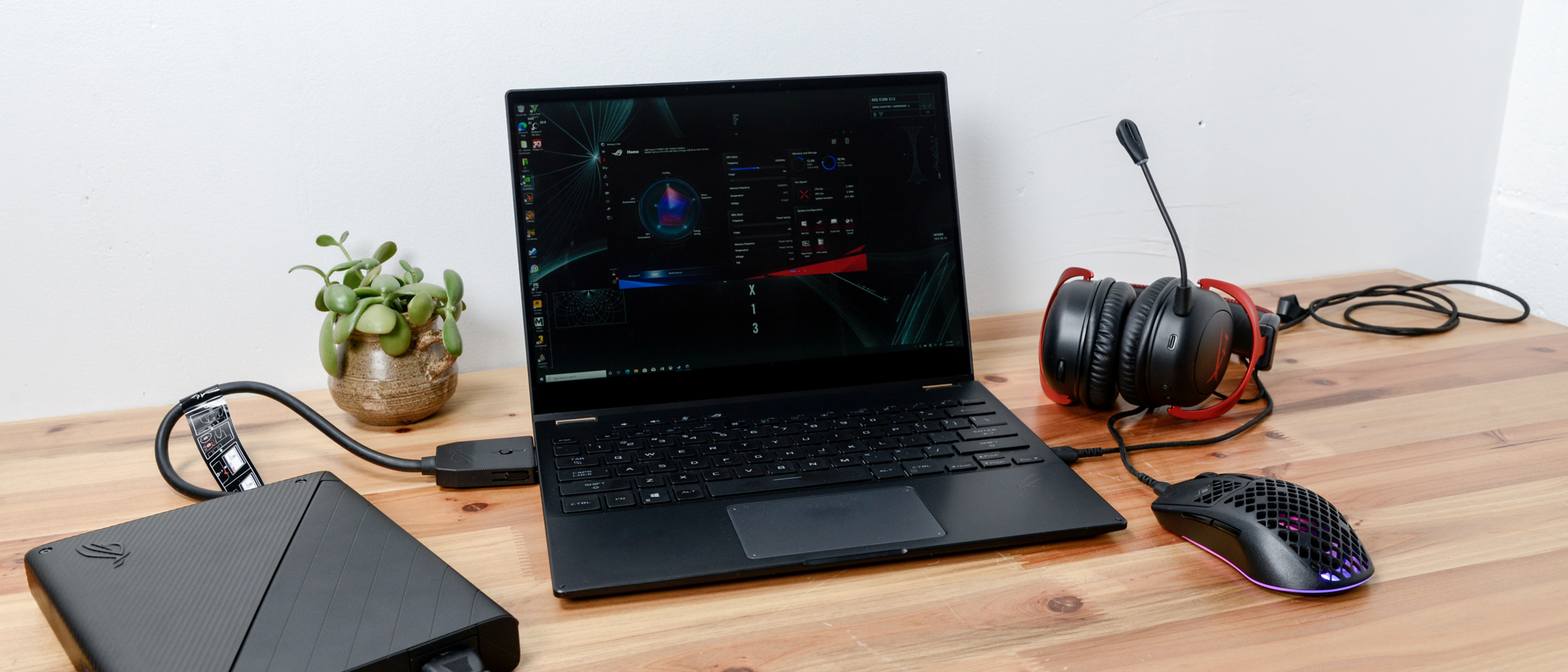Laptop Mag Verdict
The Asus ROG Flow X13 gives gamers versatility, power, endurance and innovation in one gorgeous chassis.
Pros
- +
Head-turning, versatile design
- +
Great gaming and overall performance
- +
Excellent battery life
- +
XG Mobile is a compact, portable eGPU
Cons
- -
Keys are a bit small
- -
Display could be brighter and more vivid
- -
Expensive
Why you can trust Laptop Mag
Alright dear readers, this one’s a twofer, because Asus continues to push the boundaries of what can or even should be a gaming laptop. This time around, it’s the Asus ROG Flow X13, one of the few 2-in-1 gaming laptops available. This 13-inch marvel is powered by one of AMD’s new Ryzen 5000 processors, which promises big performance and endurance gains as well as an Nvidia GTX 1650 GPU.
But wait Sherri, I thought you said this was a gaming laptop. You’re right, I did. I also said this review was a twofer. In order to unlock the Flow X13’s true potential, Asus created the XG Mobile, which without a doubt is the cutest eGPU I ever did see. You see, in this itsy-bitsy box lies the unbridled power of an Nvidia RTX 3080 GPU. Together, the Asus ROG Flow X13 and the Asus ROG XG Mobile transform into a $3,299 gaming behemoth.
Is it expensive? Yes. Is it innovative? Yes. Is it worth it? Read on to find out.
Asus ROG Flow X13 pricing and configurations
Price: $3,299
CPU: AMD Ryzen 9 5980HS
GPU: Nvidia GeForce GTX 1650 Max-Q/RTX 3080
RAM: 32GB
Storage: dual 1TB PCI m.2 SSDs in RAID 0 configuration
Display: 4K, 60Hz
Battery: 6:30
Size: 15.7 x 11.6 x 0.7~0.9 inches
Weight: 2.9 pounds
The Asus ROG Flow X13 and the XG Mobile are a package deal. One that starts at $2,999. For that price, the Flow X13 is outfitted with a 3-GHz AMD Ryzen 9 5900HS processor with 32GB of RAM, a 1TB M.2 2230 NVMe PCIe 3.0 SSD, an Nvidia GeForce GTX 1650 Max-Q GPU with 4GB of VRAM and a 1920 x 1200-pixel display with a 120Hz refresh rate.
Asus also makes a Supernova Edition of the bundle that costs $3,299 and bumps the laptop’s CPU to a 3-GHz AMD Ryzen 9 5980HS CPU and the screener resolution to 4K with a 60Hz refresh rate.
Asus ROG Flow X13 design
I like looking at the Asus ROG Flow X13 almost as much as I enjoy touching it. The entirety of the Flow X13’s magnesium-alloy chassis is done in Asus’ Gravity Wave design. Thin, textured lines cover the expanse of the sandblasted chassis exterior that in practice looks like an undulating dune of black sand, creating unexpected uniformity at the behest of a chaotic wind. Those raised ridges aren’t just for show as they were designed to provide a comfortable, sturdier grip, similar to the Google Pixelbook Go.
Somehow, while making something that doesn’t look like anything else out there, Asus still managed to add distinctive touches to make it easily recognizable to the brand. Case in point: its subtle bisecting design was added to the lid with one side of the lid appearing darker than the other under the right lighting. Instead of the larger Republic of Gamers emblem that graces some of the company’s gaming laptops, Asus opted for a small metal faceplate placed in the bottom-right corner of the lid. On my Supernova edition, the place has a hypnotizing iridescent shine that gives the laptop a pop of unexpected flair.
Sign up to receive The Snapshot, a free special dispatch from Laptop Mag, in your inbox.

Opening the laptop reveals, not exactly a Galaxy Wave design, but a brilliantly textured palm rest with even slimmer bands that ensconce the touchpad. Will these bands make her dance? Not exactly, but close. The actual keyboard deck is baby-butt smooth and is slightly concave to house the island-style keyboard.
To make this a 2-in-1, Asus took its ErgoLift hinge and gave it 360-degree flexibility. Now instead of simply raising the keyboard several degrees, the laptop can fluidly transform from a regular clamshell, into tent, stand or tablet modes with one-handed ease. And the pair of hinges are strong enough that it takes some vigorous shakes to jar the display out of position. Asus claims that using the Flow X13 in tent or stand mode lowers processing temps by up to 46.4 degrees Fahrenheit.
For a gaming laptop, the 11.8 x 8.7 x 0.6-inch Flow 13 is astonishingly lightweight at 2.9 pounds. It’s considerably lighter than a similarly specced gaming ultraportable, the Razer Blade Stealth 13 (3.1 pounds, the 12 x 8.3 x 0.6 inches. But compared to other ultralight systems, like the Asus ZenBook 13 UX325EA (2.5 pounds, 11.9 x 8 x 0.5 inches), HP Spectre x360 (2.7 pounds, 12.1 x 7.7 x 0.7 inches) and the Dell XPS 13 (2.8 pounds, 11.6 x 7.7 x 0.6 inches) it’s still a bit chunky. In fact, only the MacBook Pro 13, M1 (12 x 8.4 x 0.6 inches) is heavier at 3 pounds.
Asus ROG XG Mobile design
This might be the smallest eGPU ever. And if not, it’s the smallest I’ve seen. The XG Mobile weighs in at only 2.2 pounds and measures a scant 8.2 x 6.1 x 1.2 inches. Combined with the Flow 13, that’s 5.1 pounds, meaning you can easily throw both into a bag to game on the road.
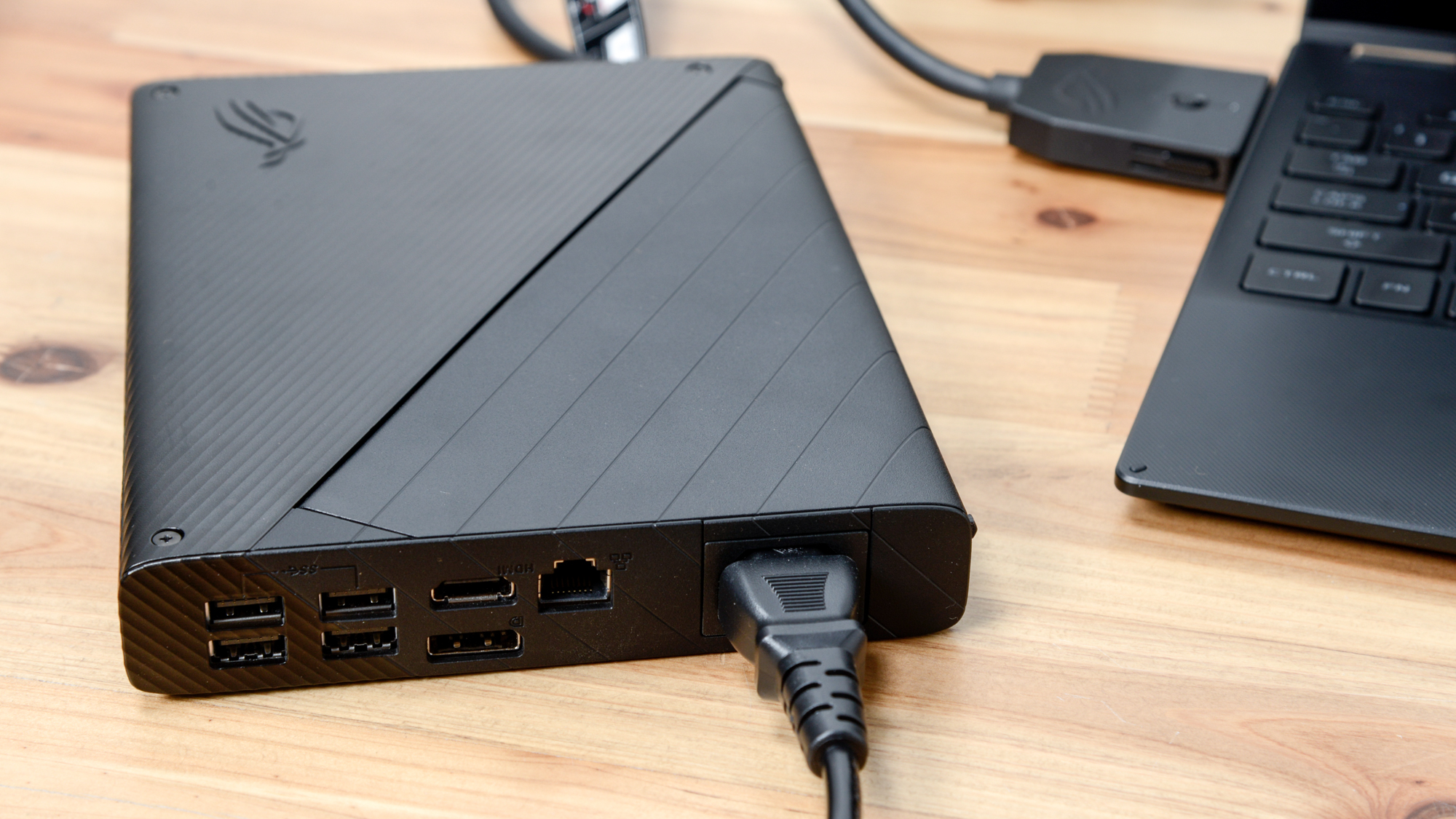
Like its laptop partner, the XG Mobile rocks the Gravity Wave design, but only partially. Staying true to that Asus love of design duality, most of the enclosure is Gravity Wave, but the rest of the magnesium alloy casing features flat, thicker bands. An ROG emblem sits prominently on top in the right corner while a funky vent that spells ROG occupies the lower left rear corner. On the right side of the box is a sizable vent while a large assortment of ports sits on the left (more on that later).
Asus ROG Flow X13 security
Something is better than nothing, especially when it comes to security features. The Asus ROG Flow X13 has a Windows Hello-compliant fingerprint scanner hidden in its side-mounted power button. After scanning your prints into the system, logging in takes just a simple touch.
Asus ROG Flow X13 ports
Similar to most ultraportables, the Asus ROG Flow 13 doesn’t offer many ports. On the right, there’s a USB 3.2 Gen 2 Type-A port, a USB 3.2 Gen 2 Type-C port and the power button. Along the left sits a proprietary jack for the XG Mobile and another USB 3.2 Gen 2 Type-C port, an HDMI 2.0 port and a headset jack. The proprietary jack is covered by a rubber cover with a little ROG logo stamped on the front.
Asus ROG XG Mobile ports
In order to make up for the Flow X13’s port shortage, Asus gives you just about all the ports and slots you can want on the XG Mobile. There’s a full SD card reader at the top of the enclosure and four USB 3.2 Gen 1 Type-A ports, an HDMI 2.0 port, a DisplayPort 1.4, Gigabit Ethernet and a DC input jack.
Asus ROG Flow X13 display
The ROG Flow X13 has a 13.4-inch, 3840 x 2400-pixel touch display, similar to the XPS 13. It manages to get this super-high-resolution display thanks to smaller bezels along the top and the sides of the panel. However, the chin is still a bit thick, especially when compared to the XPS 13’s near bezel-less InfinityEdge design.
I played CyberPunk: 2077 for its unending parade of high-gloss neons and I was not disappointed. I camped out in my apartment waiting for day to turn to night and was treated to a glowing metropolis painted in neon pink, blue and yellow. It didn’t matter that I couldn’t see the stars in the night sky because the city was the only light show needed.
When I watched the Samsara trailer, I was awestruck by the crisp details and striking hues. I saw nearly every detail in the lead dancer’s sunflower yellow costume, including the sparkling sequins and delicate scales in the headpiece. The blood-red jewels in the headpiece popped from their emerald green perch.

The color looked so good that I was genuinely surprised when the 4K panel had a narrow 69.9% of the DCI-P3 color gamut. It’s well below the 85.6% premium laptop average. It just edged out the XPS 13’s 69.4% but the Spectre, ZenBook and MacBook Pro were all more vivid at 77.4%, 76.1% and 78.3%, respectively.
The Flow X13 also fell short on our brightness test, measuring only 282 nits and missing the 388-nit category average. The Spectre and ZenBook reached 369 and 370 nits, respectively, while the MacBook and XPS 13 presented a dazzling 435 and 469 nits.
If you’re not a fan of the current screen color temperature, you can toggle it on and off with the GameVisual utility in the Armoury Crate app. Aside from the Default option, there are seven additional presets including Racing, Scenery, RTS/RPG, FPS, Cinema, Eyecare and Vivid. Or you can adjust the temperature yourself. Gamevisual also offers a color calibration feature.
The capacitive touch display was agile and responsive, allowing me to quickly draw a rudimentary flower. But if you don’t want to smear the screen, the Flow X13 is compatible with the Asus Pen, which offers 1,024 pressure levels.
Asus ROG Flow X13 audio
I wasn’t too surprised when the Flow’s pair of bottom-firing speakers and smart amplifier didn’t fill my smallish testing space. However, I appreciated that despite its limitations, the speakers still delivered relatively clear audio with accurate details.
I took on one of the fight club missions on CyberPunk and was rewarded with the sound of meaty punches connecting with flesh. The roar of the crowd in the background really got my mojo working although the sad guitar chords playing in the background were a bit off-putting. Still, the audio was on point.
When I listened to Fourshee’s “single af,” I was impressed by the bass guitar twangs on the opening and how clear the synthesized keyboard sounded. It had an airy quality that really complemented the plaintive vocals declaring the artist’s relationship status.
Asus ROG Flow X13 keyboard
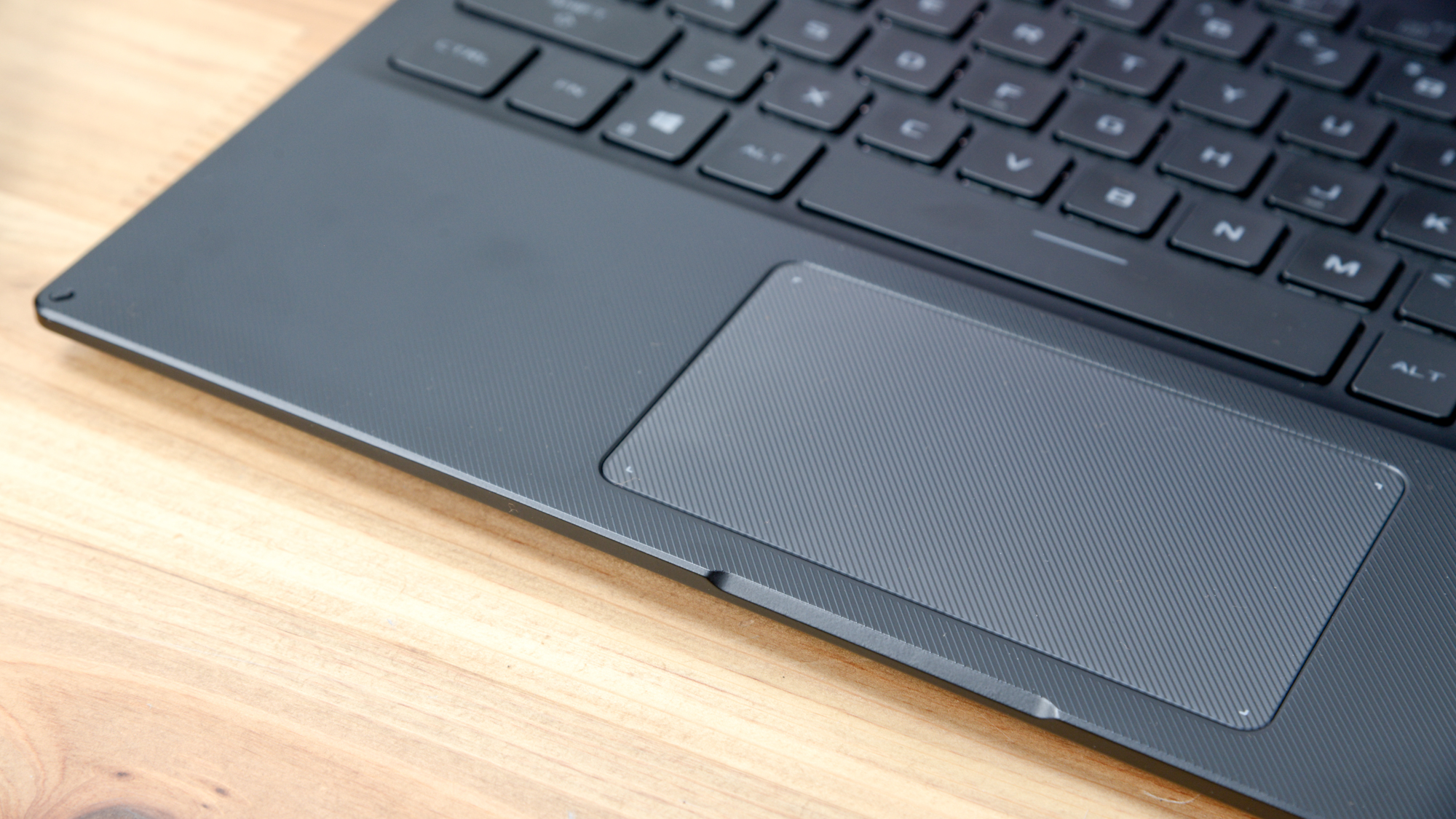
The Asus ROG Flow X13’s island-style keyboard delivers strong, forceful feedback that makes for a comfortable typing experience. I just wish the keys were a bit bigger. Even with my skinny fingers, I found myself hitting neighboring keys as I typed. It dropped my usual 70 words-per-minute average to 58 wpm on the 10fastfingers typing test.
Unlike your typical gaming laptop, the Flow X13 doesn’t allow you to create a circus of RGB color with the keyboard. Instead, you get a white backlit keyboard with three levels of brightness. It would be cool to have a laptop this small glowing like a disco ball like a Razer Blade Stealth or the Razer Book 13, but I guess you can’t have everything.
The 4.1 x 2.4-inch touchpad gave me sufficient space to perform all those Windows 10 gestures we know and love. I pinch-zoomed, two-finger scroll and three-finger switched windows to my heart’s content with quick, accurate responses.
Nvidia 30-series GPUs unleashed
Thanks to the XG Mobile with its Nvidia GeForce RTX 3080 GPU and 16GB of video memory, the Asus ROG Flow X13 joins an elite club –– the Nvidia 30-series gaming club. Nvidia’s new chips bring faster performances with twice the efficiency. The new 30-series chip uses Nvidia’s 2nd-generation RTX Ampere architecture, which is the company’s first 8nm chip. Despite the smaller size, Nvidia still managed to fit even more transistors on the chipset. How many more? Billions. More transistors means more power, which is rarely a bad thing.
Made using a custom system, for all intents and purposes, Ampere chips are three processors in one. You’ve got the Shader, which handles 3D shading (lighting, darkness, color levels) in a rendered image as well as other post-processing functionality. There are 2nd-generation RT Cores, which handle that all-important ray-tracing technology and a 3rd-generation Tensor Core, which powers artificial intelligence calculations.
But what’s the use of all that power without some kick-ass functionality? With the Ampere chips, 30-series laptops will bring a host of gamer-centric features, including the 3rd-generation of Max-Q design, which brings with it Dynamic Boost 2.0 and WhisperMode 2.0. Powered by AI, Dynamic Boost 2.0 intelligently sends power between the processor, GPU and VRAM as necessary for that efficiency I mentioned earlier. The improved WhisperMode also works with the CPU and GPU as well as the laptop’s fans. By monitoring system temperature, WhisperMode provides the optimal acoustics so you don’t have to worry about blaring fan noise.
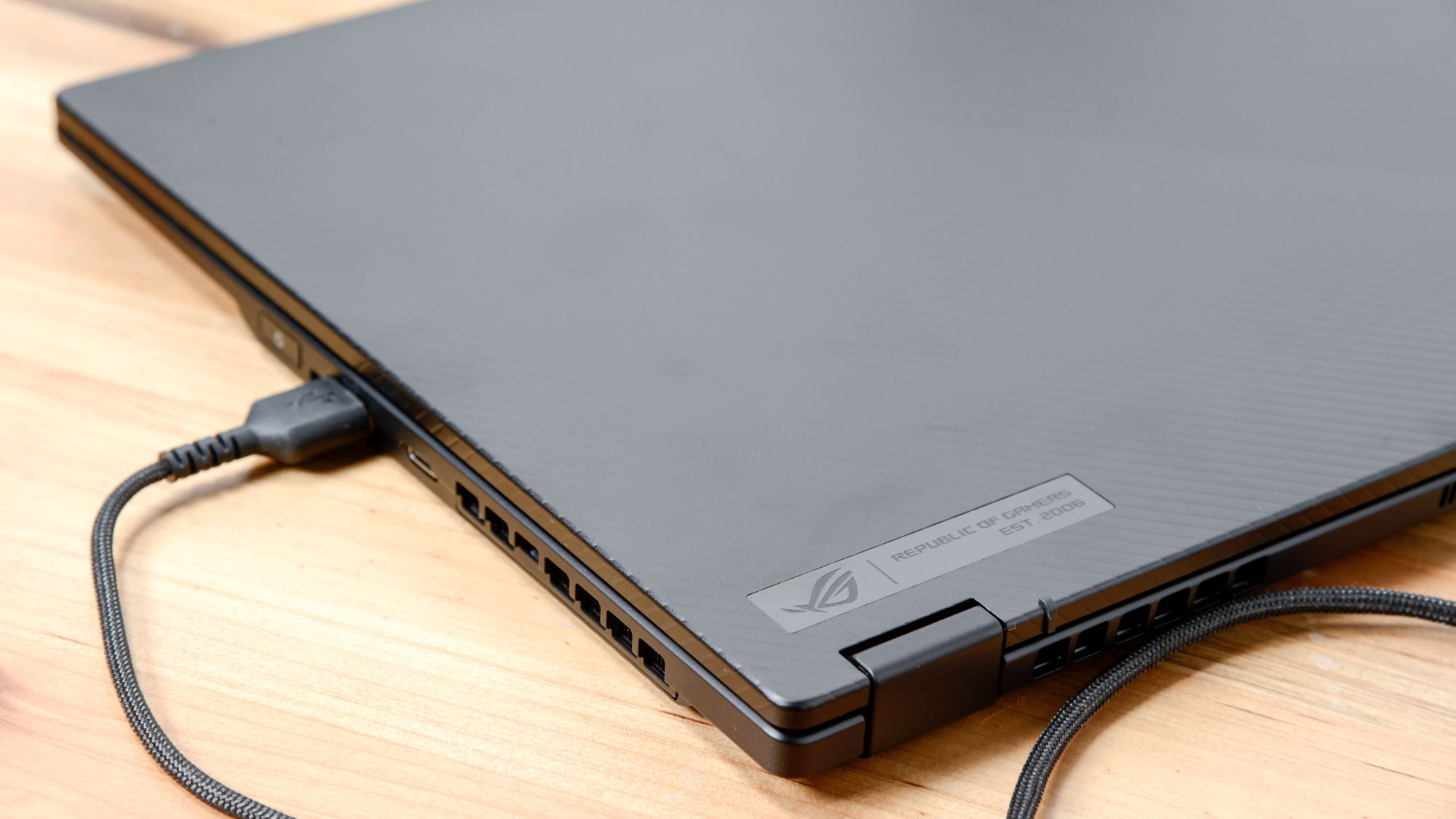
Another AI-powered feature is DLSS or Deep Learning Super Sampling. DLSS allows a gaming laptop, which has more pronounced power restraints, to achieve 2x the performance without exceeding thermal or power limits. It helps deliver those high frame rates you’ve come to expect from a high-end Nvidia system.
Nvidia’s Optimus technology has also gotten an upgrade. For the uninitiated. Optimus automatically switches between integrated and discrete graphics to preserve battery life. Less taxing programs use integrated GPUs while games, photo and video-editing software will tap into discrete GPUs. This latest iteration of the feature, called Advanced Optimus, uses a hardware switch that controls which GPU is connected to the display at any given time.
Unlike previous versions, Advanced Optimus plays nice with Nvidia’s G-Sync technology. G-Sync matches up the display’s refresh rate with the GPU for a smoother, faster gaming experience. With Advanced Optimus, gamers get the benefit of longer battery life, and displays pushing out higher refresh rates (1440p displays at 240Hz and 4K at 120Hz). The feature can be toggled between Automatic, Optimus and Nvidia GPU-only in the Nvidia Control Panel.
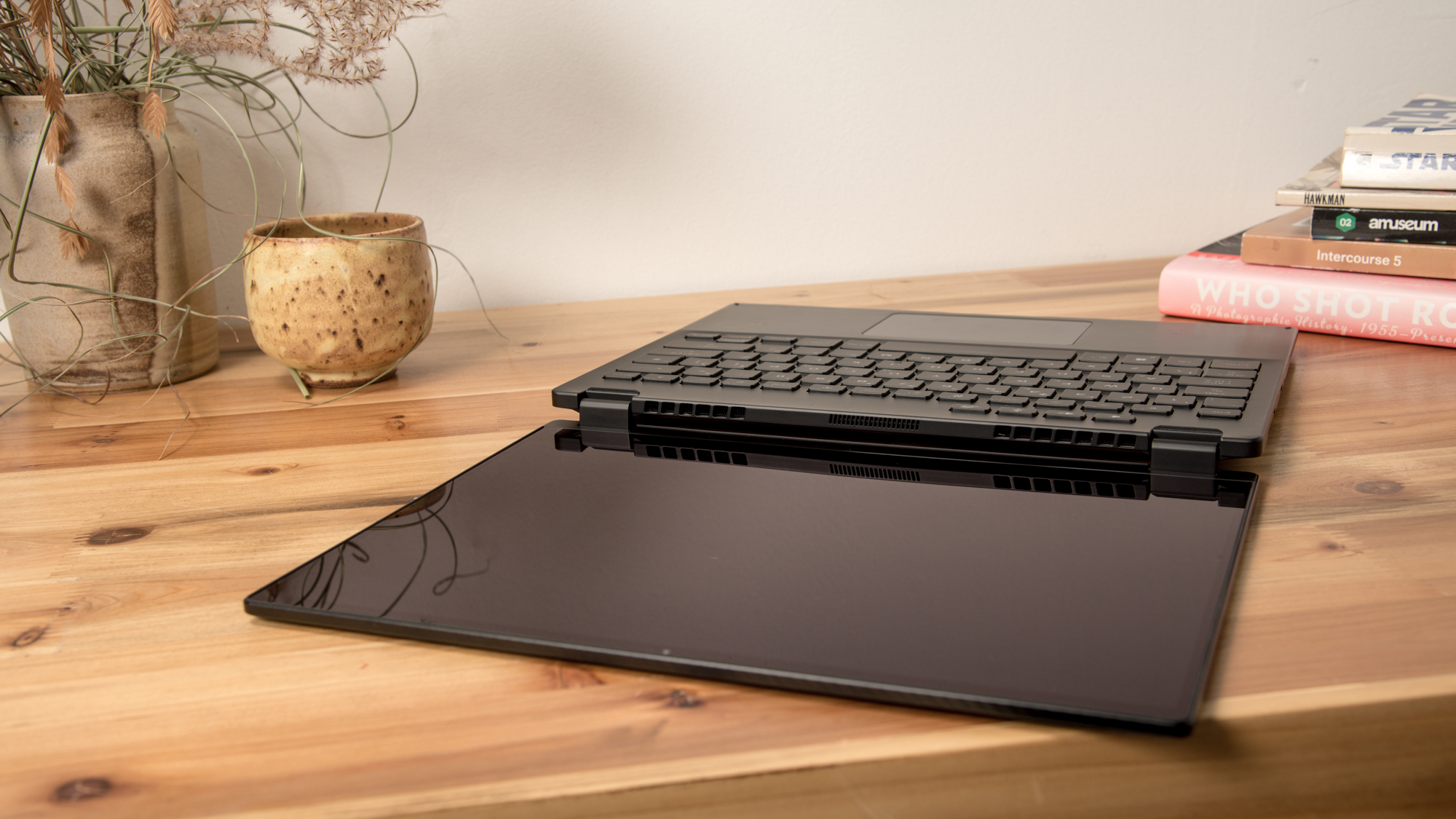
Speaking of displays, you’re going to see a lot more gaming laptops with 1440p display options and super high refresh rates. This is by design. Although we are seeing a lot more 4K panels, some with refresh rates higher than 60Hz, 1440p panels with 240Hz hit that sweet spot of super-high resolution graphics and a super-high refresh rate that gamers will more often than not appreciate.
Another performance enhancement comes by way of the Resizable Bar. Instead of the video memory having to process smaller processing requests at a time, Resizable Bar allows the CPU to access the framebuffer capability in one big batch, which is better for performance.
Other Nvidia goodies are Reflex, which uses G-Sync tech to cut down on latency, the bane of any gamer’s existence. Broadcast allows you to turn a meager gaming nook into a passable streaming headquarters by way of AI functionality, which cancels out ambient noise, automatic webcam framing, and the ability to create virtual background effects.
Asus ROG Flow X13 graphics and gaming
Asus equipped the ROG Flow 13 with its own discrete graphics card, the Nvidia GeForce GTX 1650 Max-Q GPU, which let’s be honest, isn’t going to set the world on fire. But it can play more than a few older titles at a decent frame rate. The current AAA titles? Not so much.
For instance, when we ran the Assassin’s Creed Odyssey on high at 1080p, the convertible notched 25 frames per second, which is below our 30-fps threshold. Meanwhile, the notebook spit out 20 fps on Borderlands 3 at 1080p and only 5 fps at 4K. On Far Cry New Dawn, we saw 22 fps at 1080 and 14 fps at 4K.
The laptop actually surpassed our threshold on the Grand Theft Auto V, reaching 35 fps at 1080p. But the frame rate dropped on Metro: Exodus (Ultra) to 21 fps on DX11 at 1080p and 9 fps at 4K. During Red Dead Redemption 2 at 1080p, the Flow X13 scored 21 fps. Finally, when we ran the Shadow of the Tomb Raider benchmark, the notebook produced 25 fps on 1080p and 6 fps at 4K.
Asus ROG XG Mobile graphics, gaming and VR
So here we are, the moment you’ve been waiting for. That moment when the Flow X13 combines with the XG Mobile and forms the gaming laptop version of Volton and competes with the likes of the Alienware and MSI. Connecting the eGPU to the laptop is simple: just plug the XG Mobile into an outlet and plug the proprietary cable into the laptop. Almost instantly, you’ll get a prompt informing you to slide the locking switch into place and to click OK to connect. Next, you’ll hear a happy chirp letting you know it’s time to rock and roll.
This time, when we ran the Assassin’s Creed Odyssey, the Flow X13’s frame rate jumped to 68 fps at 1080p and 34 fps on 4K, beating the 61-fps premium gaming laptop average. The Alienware m15 (RTX 3070 GPU) was right behind with 67 fps at 1080p, as were the MSI GS66 Stealth’s 66 fps (RTX 3080 GPU) and the Gigabyte Aero 15’s (RTX 3070 GPU) 65 fps.
The Flow X13 and XG Mobile stumbled a bit on the Shadow of the Tomb Raider test, scoring 66 fps, which is short of the 72-fps average. However, it was enough to top the Asus ROG Zephyrus 14 (RTX 2060 GPU), which notched 49 fps. The Aero 15, m15 R4, and Stealth obtained 76 fps, 77 fps and 87 fps, respectively.

When we ran the Grand Theft Auto V test, the Flow X13 achieved 104 fps, dusting the 87 fps average, the Aero 15 (96 fps) and the Stealth (97 fps). However, the m15 R4 (108 fps) and G14 (115 fps) outperformed the competition. Changing the settings to 4K got the Flow X13 to 31fps, beating the 29 fps average and the Aero 15’s 30 fps, but not the m15’s 35 fps.
During the Metro: Exodus RTX benchmark, the Flow X13 produced 61 fps, surpassing the 55-fps category average. The Alienware, Stealth and Aero obtained 66 fps, 63 fps and 55 fps, respectively. At 4K, we saw the Flow X13’s frame rate fall to 33 fps, just below the 34-fps average while the Aero 15 dropped to 32 fps and the m15 R4 came out on top at 40 fps.
The Flow X13 produced 83 fps, which is just a couple of frames short of the 85-fps category average, but still beat the G14’s 73 fps. However, the Aero 15 and its 97 fps led the pack followed by the Stealth (93 fps) and m15 R4 (91 fps). Cranking the resolution to 4K, the Flow X13 got 48 fps, defeating the 44-fps average. The Aero 15 and m15 R4 hit 50 fps and 56 fps, respectively.
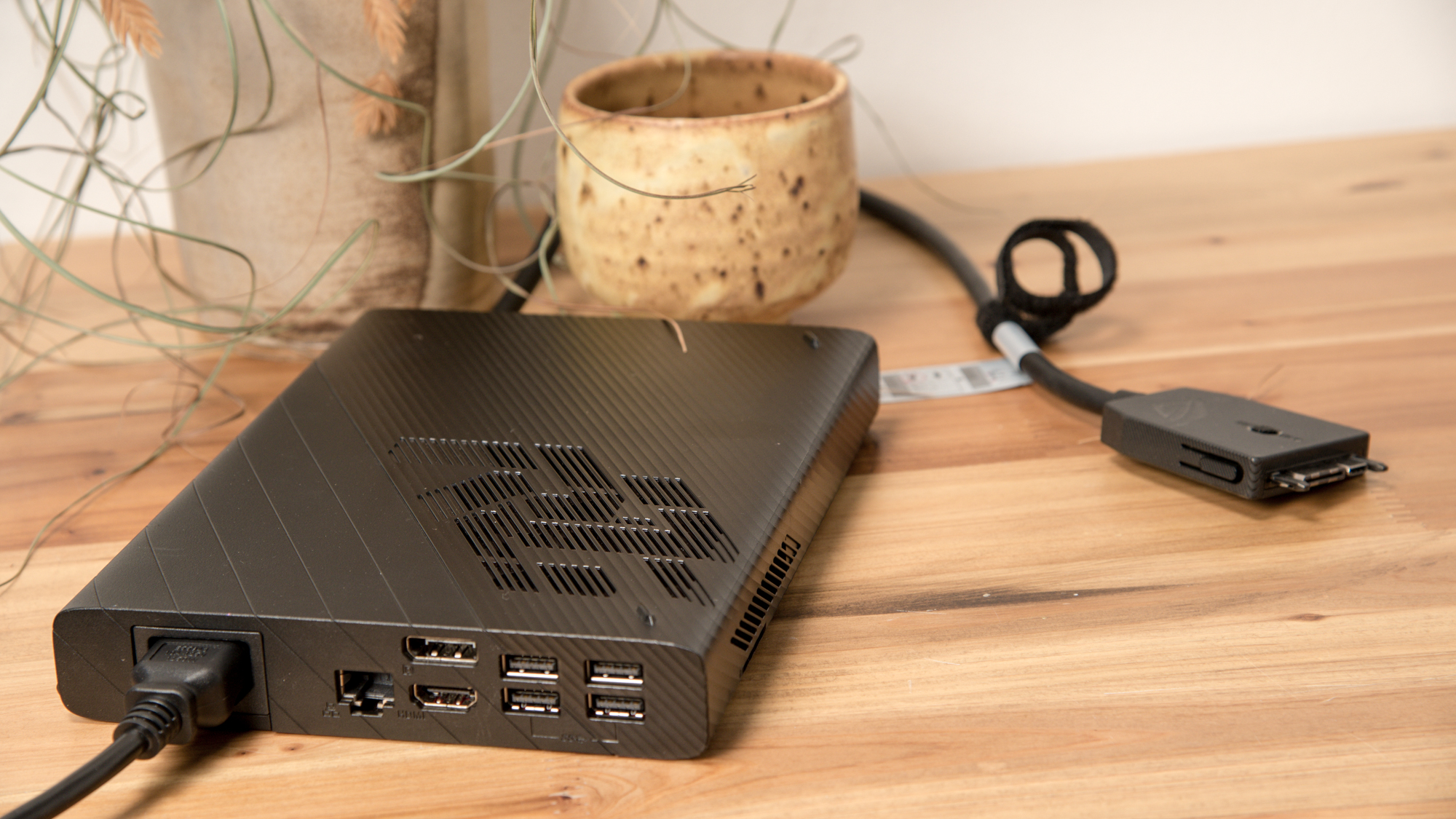
On the Borderlands 3 test, the Flow X13 served up 77 fps, sailing past the 66-fps premium gaming laptop average and the Aero 15 (70 fps). The Alienware m15 R4 reached 85 fps while the Stealth was right behind at 84 fps. Switching over to 4K, the Flow X13 and Aero 15 tied at 27 fps, creeping past the 23-fps average while the m15 R4 took the lead with 34 fps.
Finally, we ran the Red Dead Redemption 2 benchmark and the Flow X13 reached 65 fps. That was enough to top the Aero 15’s 58 fps and the 55-fps category average. Meanwhile, the Alienware obtained 69 fps while the Stealth hit 71 fps. At 4K the Flow X13 secured a frame rate of 33 fps, crushing the m15 R4’s 27 fps as well as the Aero 15 and category average’s matching scores of 22 fps.
To test for VR readiness, we ran VRMark Blue (the most taxing benchmark) and the Flow 13 with an assist from the XG Mobile scored 3,002, toppling the 2,566 average. The Aero 15 (2,726), Zephyrus (1,695) and Stealth (1,685) couldn’t come close, but the Alienware still managed to grab the top spot with 3,111.
Meet AMD Ryzen 5000 Series
AMD made a triumphant return to laptops last year, delivering surprising performance as we witnessed in the Acer Swift 3 and endurance from the Zephyrus G14, our current longest-lasting gaming laptop. The company is planning to make a repeat performance with its new 5000 series mobile processors. Built on AMD’s 7nm Zen 3 architecture, the company is promising big boosts to performance and battery life.
So what makes the 5000 series so special? With the Zen 3 architecture, AMD is bringing a lot of desktop features to mobile. And AMD will finally have a larger presence in the world of high-end gaming laptops. And since we’re talking about gaming, we’re going to focus on AMD’s new H-series lineup, which like other Ryzen chips, are designated by Ryzen 3, 5, 7 and 9.
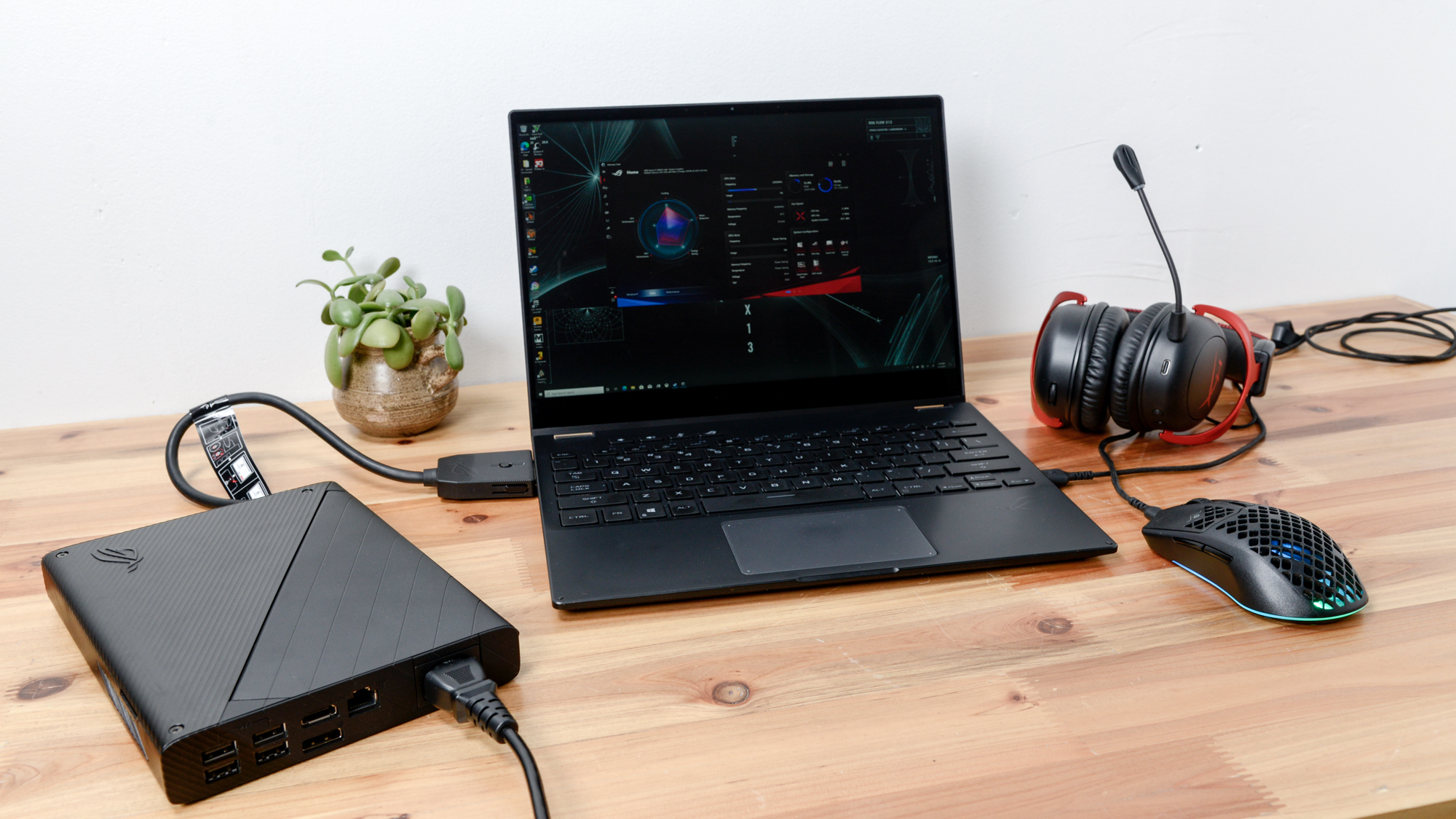
The AMD Ryzen 9 5980HS CPU is a flagship component, serving up 8 cores and 16 threads and a base clock speed of 3.0GHz that can be boosted to 4.8GHz, which AMD dubs as the “fastest mobile processors you can get.” But if you need even more power, keep your eyes out for the upcoming HX chips, like the overclockable Ryzen 9 5980 HX, which has a max clock speed of 4.8GHz.
Some key improvements have been made over last year’s Zen 2 line. In addition to the higher boost clocks, all of the new chips will have threading enabled and use CPPC (Collaborative Power and Performance Control). That means you can expect more performance at more efficient rates which translates into longer battery life — this is sure to be a boon for gaming laptops.
Asus ROG Flow X13 performance
Teeny-tiny laptop with a bag full of kickass. Powered by a 3-GHz AMD Ryzen 9 5980HS processor with 32GB of RAM and a 1TB M.2 2230 NVMe PCIe 3.0 SSD, the Asus ROG Flow X13 didn’t come to play games. Well, technically it did, just not with the competition. The little convertible allowed me to run 40 Google Chrome tabs without incident without the XG Mobile attached. The number increased to 50 with the eGPU connected while playing Control.
The system continued with its winning ways during our synthetic tests, churning out a result of 8,121 on the Geekbench 5.3 overall performance test. It was more than enough to defeat the 7,427 premium gaming laptop average. With their Intel Core i7-10870H CPUs, the Aero 15, m15 R4 and Stealth delivered marks of 8,009, 7,636 and 6,050, respectively.
The Flow X13 transcoded a 4K video to 1080p in 8 minutes and 13 seconds, which is faster than the 8:24 average as well as the Stealth (9:01). However, the Aero 15 was slightly more agile at 8:10 while the Alienware (7:07) and Zephyrus (6:59) blazed ahead.
During the File Transfer test, the Flow X13 duplicated 5GB of multimedia files and posted a transfer rate of 1,339.3 megabytes per second. That was more than enough to keep the Aero 15 (879 MBps, 1 TB SSD), Alienware m15 R4 (1,055 MBps, 1TB SSD) and Zephyrus (1,131 MBps, 1TB M.2 NVMe SSD) at bay, but not the Stealth and its 1TB NVMe SSD, which got a rate of 1,413.6 MBps.
Asus ROG Flow X13 battery life
Asus has the ROG Flow X13 rated for 10 hours of battery life. It fell short of the mark, lasting only 6 hours and 30 minutes on the Laptop Mag Battery Test, but that’s still a great time for a gaming laptop. Plus, it beat the 4:48 premium gaming laptop average which is coincidentally when the Aero tapped out. The m15 R4 powered off after 4:01 while the Stealth ran out of juice after 6:27. The Zephyrus was the last laptop standing with a time of 11:32.
Asus ROG Flow X13 heat
The smaller the system, the harder it is to keep cool, especially when it’s a gaming laptop. To counter this, Asus rolled out its ROG intelligent cooling system which has several components: liquid metal compound in lieu of thermal paste, a self-cleaning thermal module, new Arc Blade fans with 84 blades, several heat sinks and heat pipes.
While none of these kept the laptop from surpassing our 95-degree Fahrenheit comfort threshold during our gaming heat test, it allowed me to use the system in my laptop for long periods of time. After 15 minutes of gaming, the touchpad measured 83 degrees while the middle of the system and undercarriage registered 109 degrees and 115 degrees, respectively.
We let the laptop cool down and ran our 15-minute video test where we played a fullscreen HD video and remeasured the tempts. The touchpad, center and bottom had temperatures of 83, 96 and 100 degrees each.
Asus ROG Flow X13 webcam
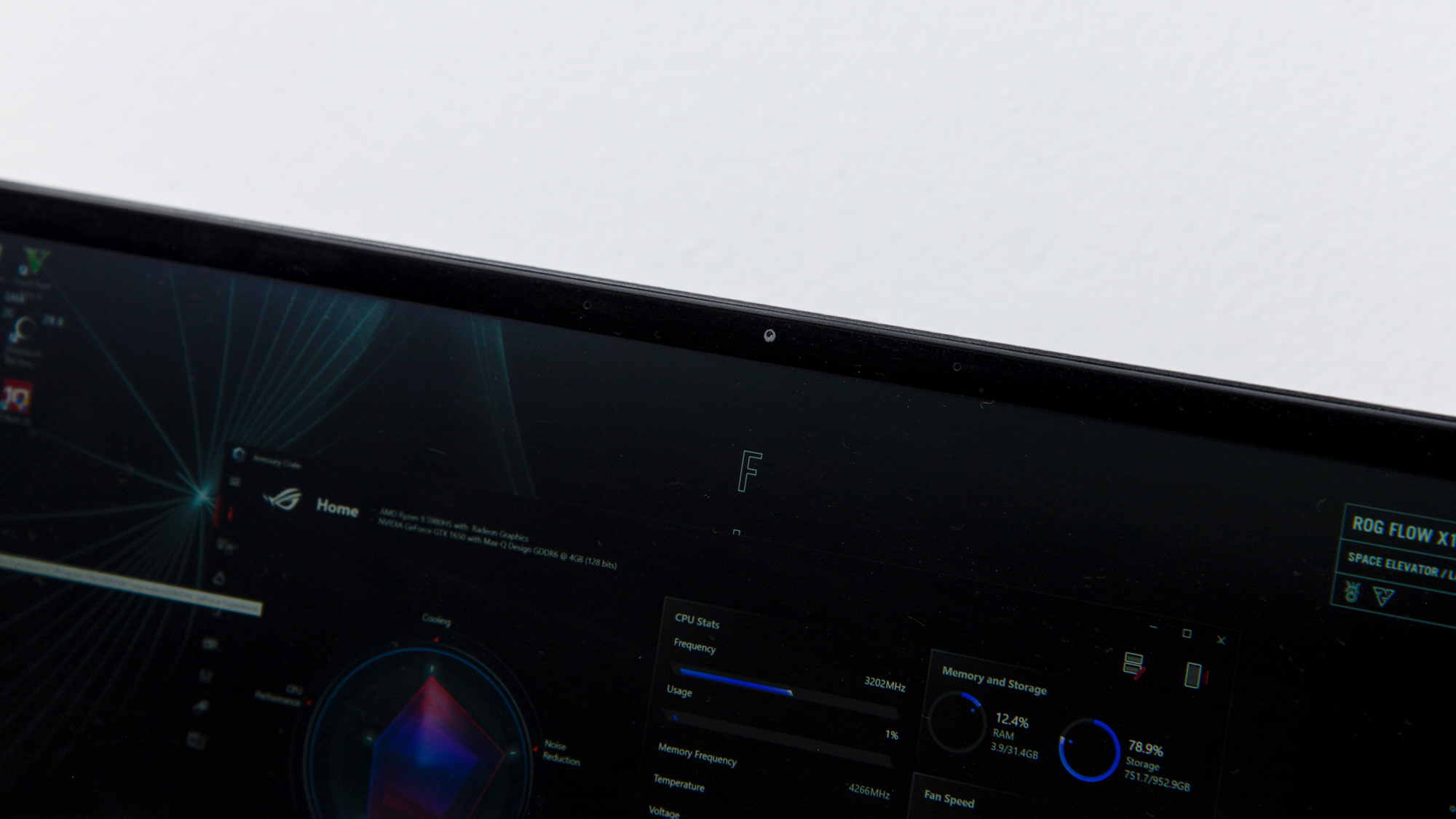
The Asus ROG Flow X13’s 720p webcam takes surprisingly good pics. I’d still recommend investing in an external webcam for streaming, but if you’re in a pinch, it’ll do. The shooter delivered accurate color from my rose pink blouse to my pink, purple and blue locs. And while some details, like the fabric pattern in my couch, were blurry, I could see the fine lines in my shirt and the creases in the leather recliner in the background.
Asus ROG Flow X13 software and warranty
Asus has pre-installed several pieces of branded software onto the ROG Flow X13. The most important of which is Armoury Crate. A one-stop-shop of sorts, Armoury Crate is where you go to adjust display settings, control the various performance modes, check system diagnostics, and launch games among several other helpful features. There’s also MyAsus, which can run system diagnostics and hardware checks on your system if you’d rather not use Armoury Crate.
And if you’d rather use AMD’s software to launch games or monitor system performance, there’s AMD Radeon Software.
Of course, there’s some Windows 10 bloatware to be expected such as McAfee Personal Security, Roblox, Hulu and Hidden City: Hidden Object Adventure.
Both the Asus ROG Flow X13 and XG Mobile ship with a 1-year limited warranty. See how Asus performed during Tech Support Showdown and Best and Worst Brands, our annual special reports.
Bottom line
Asus has done it again. They’ve changed the definition of what a gaming laptop is and they’ve made me want to drop over $3K to buy into this new idea. By itself, the Asus ROG Flow X13 is a compelling laptop. It’s very rare to see a 13-inch gaming system and even rarer for it to be a 2-in-1. But Asus didn’t stop there, they threw a high-powered AMD Ryzen 9 processor into the mix and even outfitted the notebook with its own discrete Nvidia GPU. It’s compelling, not $3,299 compelling, but compelling nonetheless.
It’s when the XG Mobile comes into play where things get interesting. For the life of me, I’m baffled about how they fit an RTX 3080 into such a small enclosure. Even though I wish Asus could have found a more elegant solution than that huge proprietary plug, I can’t argue with results. The XG Mobile is the proverbial trap card, transforming it into the dark magician of gaming laptops. It doesn’t have any right to be as powerful as it is, but here we are, again impressed by Asus’ ingenuity.

Sherri L. Smith has been cranking out product reviews for Laptopmag.com since 2011. In that time, she's reviewed more than her share of laptops, tablets, smartphones and everything in between. The resident gamer and audio junkie, Sherri was previously a managing editor for Black Web 2.0 and contributed to BET.Com and Popgadget.
